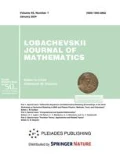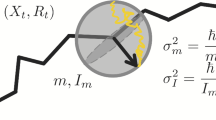Abstract
In this work, we consider a pair of qubits controlled by coherent and incoherent controls. The dynamics of the two-qubit system is driven by a Gorini–Kossakowsky–Sudarchhan–Lindblad master equation where coherent control enters into the Hamiltonian and incoherent control inters into both the Hamiltonian (via Lamb shift) and the dissipative superoperator. Two classes of interaction between the system and the coherent field are considered. For this system, we analyze the control problem of generating a given target density matrix which is formulated as minimizing the Hilbert–Schmidt distance between the final density matrix and the target density matrix. Incoherent control is modeled as a sum of constant in time Gaussians with centers related with the transitions frequencies between the energy levels of the qubits. Coherent control in general formulation is considered as measurable function and in numerical experiments as piecewise constant function with constraints on magnitudes and variations. Finite-dimensional numerical optimization is performed using the dual annealing method; the corresponding results are described for some initial and target density matrices and for some set of the parameters of the control problem.


Similar content being viewed by others
REFERENCES
D. J. Tannor, Introduction to Quantum Mechanics: A Time Dependent Perspective (Univ. Science Books, Sausilito, CA, 2007). https://www.uscibooks.com/tannor.htm.
C. Brif, R. Chakrabarti, and H. Rabitz, ‘‘Control of quantum phenomena: Past, present and future,’’ New J. Phys. 12, 075008 (2010). https://doi.org/10.1088/1367-2630/12/7/075008
K. W. Moore, A. Pechen, X.-J. Feng, J. Dominy, V. J. Beltrani, and H. Rabitz, ‘‘Why is chemical synthesis and property optimization easier than expected?,’’ Phys. Chem. Chem. Phys. 13, 10048–10070 (2011). https://doi.org/10.1039/C1CP20353C
C. Altafini and F. Ticozzi, ‘‘Modeling and control of quantum systems: An introduction,’’ IEEE Trans. Autom. Control 57, 1898–1917 (2012). https://doi.org/10.1109/TAC.2012.2195830
S. J. Glaser, U. Boscain, T. Calarco, C. P. Koch, W. Köckenberger, R. Kosloff, I. Kuprov, B. Luy, S. Schirmer, T. Schulte-Herbrüggen, D. Sugny, and F. K. Wilhelm, ‘‘Training Schrödinger’s cat: Quantum optimal control. Strategic report on current status, visions and goals for research in Europe,’’ Eur. Phys. J. D 69 (12), 279 (2015). https://doi.org/10.1140/epjd/e2015-60464-1
C. P. Koch, ‘‘Controlling open quantum systems: Tools, achievements, and limitations,’’ J. Phys.: Condens. Matter 28, 213001 (2016). https://doi.org/10.1088/0953-8984/28/21/213001
D. D’Alessandro, Introduction to Quantum Control and Dynamics, 2nd ed. (Chapman and Hall/CRC, Boca Raton, 2021).
S. A. Rice and M. Zhao, Optical Control of Molecular Dynamics (Wiley, New York, 2000).
M. Shapiro and P. Brumer, Quantum Control of Molecular Processes, 2nd ed. (Wiley-VCH, Weinheim, 2012).
P. Nuernberger, G. Vogt, T. Brixner, and G. Gerber, ‘‘Femtosecond quantum control of molecular dynamics in the condensed phase,’’ Phys. Chem. Chem. Phys. 9, 2470–2497 (2007). https://doi.org/10.1039/B618760A
K. Lyakhov, H.-J. Lee, and A. Pechen, ‘‘Some features of Boron isotopes separation by the laser-assisted retardation of condensation method in multipass irradiation cell implemented as a resonator,’’ IEEE J. Quantum Electron. 52, 1400208 (2016). https://doi.org/10.1109/JQE.2016.2623273
K. A. Lyakhov, H. J. Lee, and A. N. Pechen, ‘‘Some issues of industrial scale boron Isotopes Separation by the Laser Assisted Retarded Condensation (SILARC) method,’’ Separ. Purif. Technol. 176, 402–411 (2017). https://doi.org/10.1016/j.seppur.2016.12.021
K. A. Lyakhov and A. N. Pechen, ‘‘\({\textrm{CO}}_{2}\) laser system design for efficient boron isotope separation by the method of selective laser-assisted retardation of condensation,’’ Appl. Phys. B 126, 141 (2020). https://doi.org/10.1007/s00340-020-07445-0
K. A. Lyakhov and A. N. Pechen, ‘‘Evolution of the cold trap content enrichment factor for a specific iterative scheme of zirconium isotopes separation,’’ Lobachevskii J. Math. 41, 2342–2352 (2020). https://doi.org/10.1134/S1995080220120252
L. Wang and D. Babikov, ‘‘Adiabatic coherent control in the anharmonic ion trap: Proposal for the vibrational two-qubit system,’’ Phys. Rev. A 83, 052319 (2011). https://doi.org/10.1103/PhysRevA.83.052319
M. Rafiee, A. Nourmandipour, and S. Mancini, ‘‘Optimal feedback control of two-qubit entanglement in dissipative environments,’’ Phys. Rev. A 94, 012310 (2016). https://doi.org/10.1103/PhysRevA.94.012310
J. L. Allen, R. Kosut, J. Joo, P. Leek, and E. Ginossar, ‘‘Optimal control of two qubits via a single cavity drive in circuit quantum electrodynamics,’’ Phys. Rev. A 95, 042325 (2017). https://doi.org/10.1103/PhysRevA.95.042325
J. Hu, Q. Ke, and Y. Ji, ‘‘Steering quantum dynamics of a two-qubit system via optimal bang-bang control,’’ Int. J. Theor. Phys. 57, 1486–1497 (2018). https://doi.org/10.1007/s10773-018-3676-8
M. Bukov, A. G. R. Day, P. Weinberg, A. Polkovnikov, P. Mehta, and D. Sels, ‘‘Broken symmetry in a two-qubit quantum control landscape,’’ Phys. Rev. A 97, 052114 (2018). https://doi.org/10.1103/PhysRevA.97.052114
G. Feng, F. H. Cho, H. Katiyar, J. Li, D. Lu, J. Baugh, and R. Laflamme, ‘‘Gradient-based closed-loop quantum optimal control in a solid-state two-qubit system,’’ Phys. Rev. A 98, 052341 (2018). https://doi.org/10.1103/PhysRevA.98.052341
A. Pechen and H. Rabitz, ‘‘Teaching the environment to control quantum systems,’’ Phys. Rev. A 73, 062102 (2006). https://doi.org/10.1103/PhysRevA.73.062102
A. Pechen, N. Il’in, F. Shuang, and H. Rabitz, ‘‘Quantum control by von Neumann measurements,’’ Phys. Rev. A 74, 052102 (2006). https://doi.org/10.1103/PhysRevA.74.052102
F. Shuang, A. Pechen, T.-S. Ho, and H. Rabitz, ‘‘Observation-assisted optimal control of quantum dynamics,’’ J. Chem. Phys. 126, 134303 (2007). https://doi.org/10.1063/1.2711806
F. Shuang, M. Zhou, A. Pechen, R. Wu, O. M. Shir, and H. Rabitz, ‘‘Control of quantum dynamics by optimized measurements,’’ Phys. Rev. A 78, 063422 (2008). https://doi.org/10.1103/PhysRevA.78.063422
A. Pechen and A. Trushechkin, ‘‘Measurement-assisted Landau-Zener transitions,’’ Phys. Rev. A 91, 052316 (2015). https://doi.org/10.1103/PhysRevA.91.052316
N. B. Il’in and A. N. Pechen, ‘‘Critical point in the problem of maximizing the transition probability using measurements in an \(n\)-level quantum system,’’ Theor. Math. Phys. 194, 384–389 (2018). https://doi.org/10.1134/S0040577918030066
M. Cattaneo and G.-S. Paraoanu, ‘‘Engineering dissipation with resistive elements in circuit quantum electrodynamics,’’ arXiv: 2103.16946.
M. Rademacher, M. Konopik, M. Debiossac, D. Grass, E. Lutz, and N. Kiesel, ‘‘Nonequilibrium control of thermal and mechanical changes in a levitated system,’’ arXiv: 2103.10898.
A. Pechen, ‘‘Engineering arbitrary pure and mixed quantum states,’’ Phys. Rev. A 84, 042106 (2011). https://doi.org/10.1103/PhysRevA.84.042106
R. Wu, A. Pechen, C. Brif, and H. Rabitz, ‘‘Controllability of open quantum systems with Kraus-map dynamics,’’ J. Phys. A: Math. Theor. 40, 5681–5693 (2007). https://doi.org/10.1088/1751-8113/40/21/015
O. V. Morzhin and A. N. Pechen, ‘‘Minimal time generation of density matrices for a two-level quantum system driven by coherent and incoherent controls,’’ Int. J. Theor. Phys. 60, 576–584 (2021). https://doi.org/10.1007/s10773-019-04149-w
O. V. Morzhin and A. N. Pechen, ‘‘Maximization of the overlap between density matrices for a two-level open quantum system driven by coherent and incoherent controls,’’ Lobachevskii J. Math. 40, 1532–1548 (2019). https://doi.org/10.1134/S1995080219100202
O. V. Morzhin and A. N. Pechen, ‘‘Maximization of the Uhlmann–Jozsa fidelity for an open two-level quantum system with coherent and incoherent controls,’’ Phys. Part. Nucl. 51, 464–469 (2020). https://doi.org/10.1134/S1063779620040516
O. V. Morzhin and A. N. Pechen, ‘‘Machine learning for finding suboptimal final times and coherent and incoherent controls for an open two-level quantum system,’’ Lobachevskii J. Math. 41, 2353–2369 (2020). https://doi.org/10.1134/S199508022012029X
O. V. Morzhin and A. N. Pechen, ‘‘On reachable and controllability sets for time-minimal control of an open two-level quantum system,’’ Proc. Steklov Inst. Math. 313, 149–164 (2021). https://doi.org/10.1134/S0081543821020152
O. V. Morzhin and A. N. Pechen, ‘‘Numerical estimation of reachable and controllability sets for a two-level open quantum system driven by coherent and incoherent controls,’’ AIP Conf. Proc. 2362, 060003 (2021). https://doi.org/10.1063/5.0055004; arXiv: 2106.10146
L. Lokutsievskiy and A. Pechen, ‘‘Reachable sets for two-level open quantum systems driven by coherent and incoherent controls’’ (submitted).
Dual Annealing Optimization in SciPy. https://docs.scipy.org/doc/scipy/reference/generated/scipy.optimize.dual_annealing.html.
C. Tsallis and D. A. Stariolo, ‘‘Generalized simulated annealing,’’ Phys. A (Amsterdam, Neth.) 233, 395–406 (1996). https://doi.org/10.1016/S0378-4371(96)00271-3
Y. Xiang and X. G. Gong, ‘‘Efficiency of generalized simulated annealing,’’ Phys. Rev. E 62, 4473–4476 (2000). https://doi.org/10.1103/PhysRevE.62.4473
Solve an Initial Value Problem for a System of ODEs. https://docs.scipy.org/doc/scipy/reference/generated/scipy.integrate.solve_ivp.html.
E. Hairer and G. Wanner, Solving Ordinary Differential Equations. II. Stiff and Differential-Algebraic Problems (Springer, Berlin, 1996).
Funding
This work is performed within the State Program of the Ministry of Science and Higher Education of the Russian Federation (project no. 0718-2020-0025).
Author information
Authors and Affiliations
Corresponding authors
Ethics declarations
O. V. Morzhin http://www.mathnet.ru/eng/person30382; A. N. Pechen is a corresponding author, http://www.mathnet.ru/eng/person17991.
Additional information
(Submitted by E. A. Turilova)
Rights and permissions
About this article
Cite this article
Morzhin, O.V., Pechen, A.N. Generation of Density Matrices for Two Qubits Using Coherent and Incoherent Controls. Lobachevskii J Math 42, 2401–2412 (2021). https://doi.org/10.1134/S1995080221100176
Received:
Revised:
Accepted:
Published:
Issue Date:
DOI: https://doi.org/10.1134/S1995080221100176




